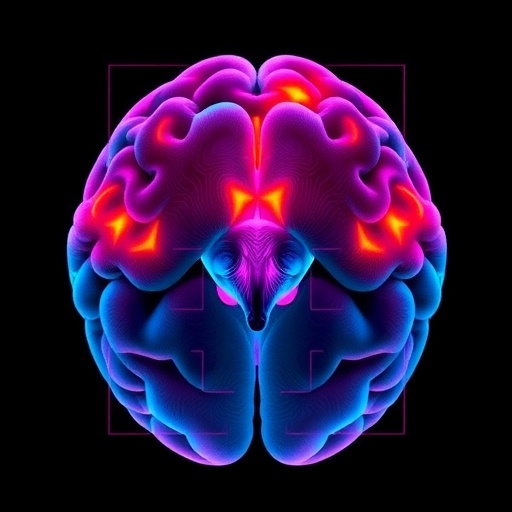New research emerging from the laboratories of Christian Wood and colleagues has unveiled critical insights into the role of the dorsolateral prefrontal cortex (dlPFC), specifically area 46 (A46), in the common marmoset brain. Their groundbreaking study implicates this brain region as a pivotal hub within a functional network that orchestrates emotional regulation, particularly concerning motivation and threat responsiveness. These processes stand at the heart of psychiatric conditions such as depression and anxiety, lending the study profound translational significance.
Central to their findings is the demonstration that inactivation of A46 yields a dual effect on emotional behavior: it attenuates reward-seeking activity, a classic symptom often associated with depressive states, and simultaneously heightens responsiveness to threatening stimuli, mirroring anxiety-like phenotypes. This bidirectional modulation emphasizes the nuanced role of A46, not merely as a passive recipient but as an active regulator balancing positive and negative emotional valences.
The dorsolateral prefrontal cortex has long been implicated in executive functions, yet its specific involvement in affective processing remained elusive. Wood et al.’s approach harnessed advanced neurophysiological inactivation techniques applied with precise spatial and temporal resolution in marmosets, nonhuman primates whose cortical architecture and emotional circuitry parallel humans more closely than rodent models. This methodology allowed for targeted disruption of A46 activity, rendering the observed behavioral changes directly attributable to this area.
Intriguingly, the team unraveled a functional network encompassing area 46 and two other prefrontal regions, areas 32 and 25, which are known to participate in affect regulation circuits. Their data suggest that this interconnected network operates synergistically to counterbalance the dysregulation produced by A46 inactivation. It is this network interplay that might underlie resilience to depressive and anxious states, offering new avenues for therapeutic interventions.
The lateralization of these effects exclusively within the left hemisphere marks a significant advance in understanding hemispheric specialization in emotional processing. Prior clinical research with neuromodulatory treatments, including transcranial magnetic stimulation (TMS) and ketamine administration, has hinted at left-dorsolateral prefrontal dominance in mediating antidepressant effects. Wood et al.’s findings lend preclinical validation to these observations, underscoring the left dlPFC as a prime target for non-invasive neuromodulation.
From a mechanistic standpoint, the study elucidates how disruption of A46 impairs reward circuitry, potentially through its downstream projections to limbic structures. The accentuated threat responsivity may arise from disinhibition within amygdalar or hypothalamic pathways. Together, these alterations in circuit function recapitulate hallmark behavioral phenotypes observed in mood and anxiety disorders, reinforcing the translational relevance of this primate model.
Moreover, the insights provided may explain in part the therapeutic efficacy and mechanisms of ketamine, an NMDA receptor antagonist with rapid antidepressant action, and TMS, which modulates cortical excitability. Both interventions are thought to recalibrate dysfunctional prefrontal networks. Pinpointing A46 and its associated network as crucial nodes advances our understanding of how these treatments normalize neural processing to alleviate symptoms.
The significance of this research extends beyond academic interest, highlighting the potential for personalizing psychiatric interventions. Current depression and anxiety treatments often face challenges of heterogeneity in patient response. Detailed circuit-level characterization, as illustrated by Wood and colleagues, heralds an era where neuromodulatory therapies might be customized based on individual brain network profiles, improving efficacy and reducing treatment resistance.
Furthermore, this study emphasizes the value of the marmoset model, positioning it as a versatile platform bridging rodent and human research. The anatomical and functional conservation of prefrontal-limbic circuits in marmosets, coupled with the ability to perform invasive manipulations, allows unprecedented exploration of neural substrates underlying complex behaviors like motivation and threat avoidance.
The findings prompt several compelling questions for future investigation. How do neurotransmitter systems within A46 influence its regulatory role? Can chronic stress or genetic vulnerability alter the structure and function of this network? What are the temporal dynamics of network compensation following A46 disruption, and how might they relate to symptom trajectories? Addressing these questions will deepen our nuanced understanding of mood disorders.
In essence, Wood et al.’s study delineates a critical circuit node that governs the delicate balance between motivation and anxiety within the primate brain. Their integrative approach, combining behavioral assays, targeted neuromodulation, and network analyses, epitomizes modern neuroscience’s capacity to decode the complexities of emotional regulation. This work not only charts new territory in affective neuroscience but also sets the stage for innovative clinical applications targeting the dorsolateral prefrontal cortex.
As the global burden of depression and anxiety continues to mount, such mechanistic insights offer a beacon of hope. By illuminating the neural underpinnings of emotional dysregulation, this research endeavours to propel the development of precision medicine strategies, ultimately improving the quality of life for millions worldwide.
Subject of Research: Neural circuitry underlying motivation and anxiety; functional role of primate dorsolateral prefrontal area 46 (A46)
Article Title: Dysfunction in primate dorsolateral prefrontal area 46 affects motivation and anxiety
News Publication Date: 21-Aug-2025
Web References: http://dx.doi.org/10.1126/science.adx4142
Keywords: dorsolateral prefrontal cortex, area 46, motivation, anxiety, depression, marmoset, functional brain network, emotional regulation, neuromodulation, transcranial magnetic stimulation, ketamine, lateralization




